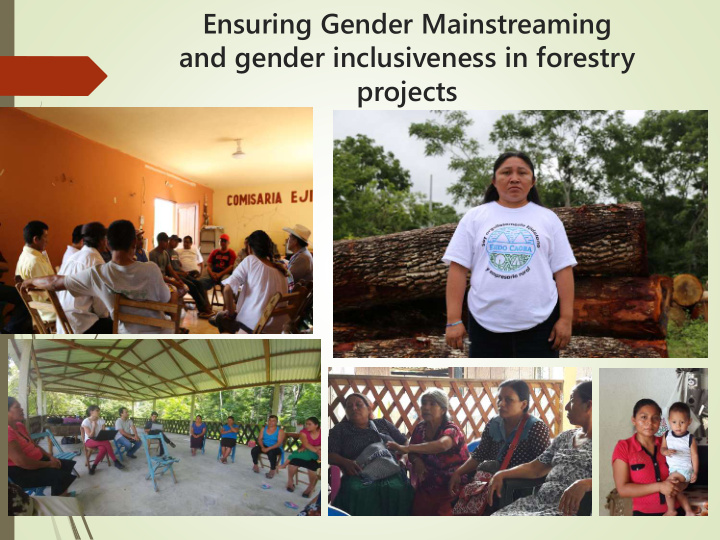



Ensuring Gender Mainstreaming and gender inclusiveness in forestry projects
Under representation of women in decision making and land ownership Women/Men Ratio in rural areas Women 51% Men 49% Source: INEGI (2011), INMUJERES (2013).
Under representation of women in decision making Rural land owners with full Beneficiaries of forestry subsidy community assembly decision- programs (self-declared; 2016) making rights Wome … Women 25% Men 81% Men 75% Forestry technical advisor positions within Representatives in communities community Women Wom management … 17% en 13% Source: CONAFOR, INMUJERES (2013), Almeida Men Men (2009), CONABIO (2016). 83% 87%
OBJECTIVES OF THE GENDER STUDY Go beyond women as mere beneficiaries: Understand the real drivers for men and empower them! women to participate in programs - Apply a behavioral science, gender- disaggregated lens - Uncover key psychological, cultural, social and material restrictions that limit women’s participation in natural resource management programs Review perception against facts by Complement existing "traditional" undertaking gender-disaggregated REDD+ and Gender studies research
Study design 1 2 3 4 5 Q1 2017: Q2 2017: Q2 2017: Q2-Q4 2017: Q1 2018: FCPF 200 Field Work Gender New funding documents with Analysis and funding and received. and data behavioral Gender new phase: bases science Action Plan: Start of the Empower studied, 11 perspective. recommenda collaboration women to interviews. tions and ENR, GSURR meet the indicators for and Emphasis on natural gender Behavioral ER-P States resource mainstreami Science Unit programs ng in NRM. (eMBeD). offer with demand.
Design of behavioral science field intervention: Selection of intervention areas Chiapas : Figure 7. The ER-P states and the 11 intervention areas 20-80% IP high land access high poverty and marginalization index low women engagement in productive NRM activities. Yucatán : Majority IP low land access low poverty and marginalization index high women engagement in NRM and communal decision making. Source : CONAFOR (2016b).
Design of behavioral science field intervention Include both men and women Different IP population related to localities, but overall in gender Yucatan mostly IP // Chiapas between 80- 20% Field work (June and July 2017) reaching 228 people: 16 focus groups 30 observations documents 15 community interviews in 8 municipalities with participation of 14 ejidos in Yucatan (8) and Chiapas (6) Collaboration with local consultant (organization of field work), a prestigious research institute (CIDE), staff of a national NGO (ODP) and support of two interpreters for indigenous languages (Mayan in Yucatan and Tojolaban, Chol, Tzotzil and Tzeltal in Chiapas)
4 focus groups to be held in each municipality: FG1 Participants “ Agency ”: Women who carry out agricultural and forestry activities and who are organized (formally or Selection of informally) Focus FG2 Participants “ Aspiration ”: Women who carry out agricultural and forestry activities Groups (not organized) Participants FG3 Participants “ Social Bias ”: Women who do not carry out agricultural and forestry activities FG4 Participants “ Influencers and Agents of Change ”: Men participating in forestry activities
RESULTS OF THE BEHAVIORAL SCIENCE FIELD INTERVENTION (1) Women assume predefined identity: Traditional roles and primarly as community stereotypes lead to gender member and mother. bias of both men and Identification as a woman women. conform with traditional mental norms. Men expect women to Women have much less fulfill their role in the time household
RESULTS OF THE BEHAVIORAL SCIENCE FIELD INTERVENTION (2) Time scarcity can be Correlation between Prevalent structural Women’s mitigated by degree of gender roles and participation in designing programs participation of norms are malleable decision-making close to household women in productive and can be processes can be and supporting labor activities and degree addressed by promoted by agents saving technologies, of their participation inducing normative, of change, role introducing choice in communal decision long-term change models and providing simplification. making and within the alternative meeting empowerment (and communities. spaces. vice versa).
Put the findings into practice 10 WITH DGM AND GO NOT ONLY TO TRANSLATE USE TRADITIONAL CIF FUNDING, WE ASSEMBLIES, BUT EVENTS, POSTER, AND LESS DESIGNED A SCHOOLS AND PAMPHLETS INTO TECHNICAL SPECIAL HOSPITALS IP LANGUAGES LANGUAGE COMMUNICATION CAMPAIGN, IMPLEMENTED 2019 HAVE WOMEN NGO SUPPORT PRESENT DGM SUPPORT … RESULTS TBD WHO ALREADY WOMEN WITH OPPORTUNITY FOR FAMILY RECEIVE SUPPORT SPANISH PAPER AND NOT NECESSARILY PRESENT WORK ONLY FOR THE INDIVIDUAL
Environmental and Social Framework (ESF) 11 and gender ESS1 ESS2 ESS3 ESS4 ESS5 Assessment and Labor and Resource Efficiency Community Land Acquisition, Management of Working and Pollution Health and Restrictions on Land Use Environmental and Conditions Prevention and Safety and Involuntary Social Risks and Impacts Management Resettlement ESS6 ESS7 ESS8 ESS9 ESS10 Biodiversity Indigenous Cultural Financial Stakeholder Conservation and Peoples/Sub-Saharan Heritage Intermediaries Engagement and Sustainable African Historically Information Management of Living Underserved Traditional Disclosure Natural Resources Local Communities
How the Environmental and Social 12 Framework (ESF) can support gender mainstreaming Gender is Take Use a Bear in mind Collect and Integrate mainstream opportunity behavioral that disaggregat gender ed – be for an in lens to meet instruments e analysis not creative depth social supply and should be socioecono only into assessment demand, to gender- mic data for project better inclusive: indigenous design but design could be populations project projects through IPPF (and by implementa with a gender for tion gender this focus, or population). through GAP
Contact Dorothee Georg, Social Development Specialist, dgeorg@worldbank.org In cooperation with WB: ENB, eMBeD, FCPF, FIP , CIF. MX: CIDE and ODP 13
Recommend
More recommend